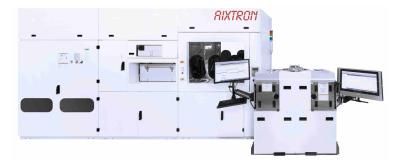Aixtron and PlayNitride signed a joint-collaboration agreement to accelerate Micro-LED development. Aixtron will deliver an AIX G5+ C MOCVD system to Playnitride, that will be used to produce GaN-based Micro LED devices.

Aixtron says that the G5+ C is an advanced advanced production tool that offers market leading wavelength uniformity to meet the tightened Micro LED market specifications in a batch reactor high-throughput environment. The system allows for the lowest defect and particle level in the industry due to an effective in-situ cleaning technology and the cassette-to-cassette handler which is essential for high yields. The G5+ C MOCVD was recently ordered by Plessey for its own GaN-on-Silicon Micro-LED development and production.
According to reports, PlayNitride aims to release its first Micro-LED display products in 2019. In 2017 the company started to sample micro-LED panels and shipped samples to 10-20 potential customers. The company's chairman and CEO, Charles Li, said in June 2018 that 5-6 of these customers are continuing the developing of micro-LED modules based on these panels.
In May 2018 PlayNitride demonstrates two Micro-LED prototypes - a small 0.89" 64x64 (105 PPI) panel with a brightness of 800 nits and a larger 3.12" 256x256 (116 PPI) panel.
In April 2018 Taiwan's Ministry of Science and Technology approved PlayNitride's application to setup a NT$500 million (US$17 million) production facility at Hsinchu Science Park. PlayNitride aims to produce micro LEDs, display modules and panels at its new facility at Hsinchu.

According to reports, Apple is in preliminary talks with PlayNitride towards a possible Micro-LED technology cooperation. It is also rumored that Samsung Display is also in talks with PlayNitride regarding a possible collaboration.
In PlayNitride's R&D setup, it takes about 10 seconds to transfer and place 200,000 LEDs - which means that a 5" panel will take only 10 minutes to produce. However the cost for a single smartphone panel could reach about $300 - much higher than the cost of even the highest-end flexible OLED. Possible applications where Micro-LED displays could succeed commercially at this stage include smartwatches, VR / AR, automotive and transparent displays.

